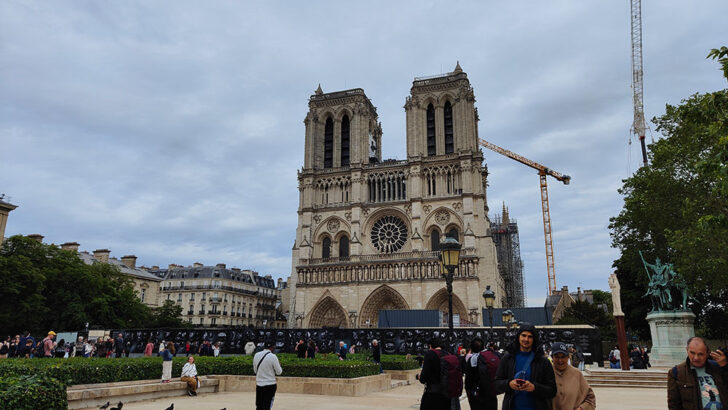Victor Hugo wrote in his The Hunchback of Notre Dame, “The greatest products of architecture are less the work of individuals than of society.” Looking through the bus window on the way from the airport to Paris, I was speechless with the number of imposing, impressive buildings.
It was windy when I got off the bus, not what I expected for a June evening in Paris. I guess the city was trying to make me feel welcome and gave me a weather similar to our well known Irish breeze.
It was my first day in Paris, something I dreamed about for a long time. I arrived to my B&B and got ready to enjoy my first evening in the French capital. I had dinner by the Canal de l’Ourcq, with a beautiful view of the Église Saint-Jacques-Saint-Christophe de la Villette.
This church was built in the 19th Century in a neoclassical style with Italian inspiration and was a fantastic background for my first few hours in the city. I felt like the area was not the most touristic, so I was able to interact with a few locals and understand a little more about French culture.
Like every tourist ever, I could not go to bed on my first night before seeing the Eiffel Tower, so I got into a metro in direction to the Alma-Marceau station.
Experiences
Visiting another country is always an experience, but I caught myself comparing Dublin and Paris a few times during my trip. We complain about not having a metro in the Irish capital nearly every day, possibly just for fun, but the Parisian metro was scary. I could not stop myself from comparing it with the Irish public transportation.
I know what you are thinking. “It was in the evening, of course weird people would be out and about.” Well, no. Throughout my trip I encountered so many people staring at me, many times around noon. I don’t know if they were all French, as I was trying to avoid the looks and pretend I did not notice it, but it was uncomfortable.
Notre Dame was saved by the famous writer Victor Hugo. The cathedral was in ruins in the 19th century”
After seeing the Eiffel Tower and taking some pictures, I was happily waiting for the sparkles but, instead, the tower’s lights went off at midnight. The solution I found to enjoy a bit more of the warm night was to rent a bike and cycle home, which gave me the opportunity to know the city and take in its beautiful sceneries.
On my first full day in the city, I did the usual tour of going to the Louvre, Arc de Triomphe and one I was the most looking forward to seeing: The Notre Dame Cathedral.
I can still remember the sadness I felt when watching the cathedral burning in the news on April 15, 2019. It has been over five years since! The first plan announced by the French president, Emmanuel Macron, was to reopen the cathedral on the fire’s anniversary, but the renovations were not done in time.
During a boat tour, the guide told us how Notre Dame was saved by the famous writer Victor Hugo. The cathedral was in ruins in the 19th century, as the building was neglected for several years after the French Revolution.
Our guide explained how the author decided to write a novel in an attempt to save the building, which worked and today Notre Dame Cathedral is one of the most important Catholic buildings worldwide.
Conflict
The church’s reconstruction is expected to be finished by the end of the year, and the reopening ceremony is scheduled for December 7. The reopening ceremony planning, however, is growing tension between the president and the Archbishop Laurent Ulrich.
The president wants to hand the building keys to the clergy, while the Archbishop believes there is no need to do that, as he already has those keys.
Another reason for conflict I read about while scrolling news about the cathedral sitting on a bench in front of the barrier fences, said that Mr Macron wants to give a speech inside the church, whilst Archbishop Ulrich wants him to speak at the forecourt.
Notre Dame is ‘a main symbol of the catholic religion, any political speech given by the president at its reopening ceremony should be given outside’”
Later, walking around in front of the church, enjoying some macarons and avoiding being hit by running children, I asked the opinions of a few tourists. Most of them had no idea about French politics and had no opinion on the case, yet a Brazilian tourist shared they “suppose for the people who believe, it would be a bit invasive if there was an opening event inside the church.”
Another tourist said that Notre Dame is “a main symbol of the Catholic religion, any political speech given by the president at its reopening ceremony should be given outside.”
After some failed attempts of getting people to talk to me, I met Laly Attal, a French student who moved to Paris a few months ago. She believes the “disagreement between President Macron and the Archbishop shows how challenging it is to balance the interests of the state and the Church.”
She explained to me how important the separation of Church and State is for the French. “I’m not sure if the speech should be inside or outside the Church. Inside, it could show respect for the sacred nature of the cathedral, but outside might better align with the idea of separation between the Church and the state,” she said.
The French State has owned the cathedral since 1905, and French newspaper La Dépêche wrote president Macron has not had many emblematic monuments credited to his presidency, and he is turning the cathedral reconstruction into a mark of his government.
Fascination
I left the church still fascinated by how political French people are and how serious they take state related matters. Cycling back to the Louvre, I could hear shouts and siren noises and decided to follow my journalistic curiosity and investigate.
A pro-Palestine march was filling the streets, while completely unbothered tourist ate sandwiches under the archway that lead to the Louvre’s gardens, and the police blocked the street on the other side.
It was a fascinating trip, full of beautiful buildings and landscapes, but with surprising amount of politics. It was interesting, and I might search about current affairs for any country I visit from now on.


 Renata Steffens
Renata Steffens Notre Dame Cathedral. Photo, Renata Steffens
Notre Dame Cathedral. Photo, Renata Steffens